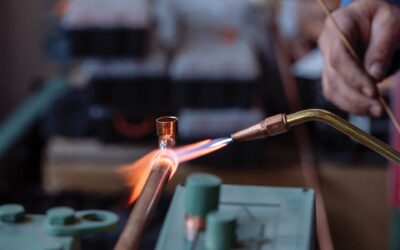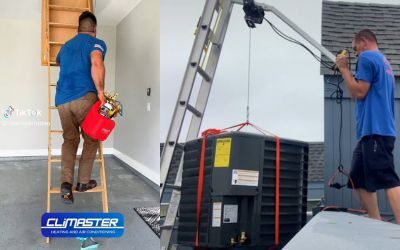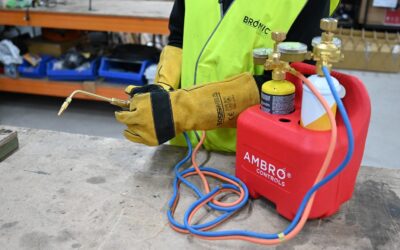
Brazing plays a crucial role in assembling HVAC systems, from connecting refrigerant lines to joining heat exchanger components. Without proper safety precautions, brazing can lead to accidents, injuries, and compromised system performance. Let’s dive into six crucial steps for brazing safely in heating, ventilation, air-conditioning and refrigeration work.
#1 Always Have PPE on Hand
As easy as it is to skip, the simple habit of using personal protective equipment (PPE) can potentially save you from burns and serious injuries. Every HVAC tech should have these essentials:
- Gloves: We recommend wearing heat-resistant gloves to protect hands from heat, sparks, and sharp edges. Gloves made of leather or rubber with insulating linings are ideal to protect areas exposed to high radiant energy.
- Goggles: Eye protection such as shaded goggles or face shields should be worn to shield the eyes from radiant heat or loose particles
- Protective Clothing: Avoid clothes with loose sleeves and ends to prevent the risk of catching fire. Clothes should be clean and free from grease and oil.
- Air-Supplied Respirators: When working in areas that are extremely confined or where excessive fumes or dust are present and cannot be avoided, respirators should be worn to protect your lungs by filtering out airborne contaminants.
2# Ventilate Confined Areas
HVAC technicians often find themselves working in tight spaces—crawl spaces, attics, or equipment cabinets. Proper ventilation is critical to prevent the accumulation of harmful fumes which can cause dangerous fires. Here’s what you need to know:
- Identify Confined Areas: Before brazing, assess the workspace. Ensure there’s enough room to move comfortably and that the area is well-ventilated.
- Use Exhaust Fans and Hoods: Set up exhaust fans or hoods to remove fumes generated during brazing. These devices help maintain clean air and reduce exposure to hazardous gases.
3# Eliminate Fire Hazards
After making sure the space is well-ventilated, you should also make sure your working space is clean and ready in case of fire:
- Inspect Brazing Area: Ensure the space is clean and free from combustible or greased materials. Always check your work area for hidden hot spots that may cause a fire. Cool down any questionable areas and do not leave until you are certain there is no danger of fire.
- Direct Sunlight: If you’re working in direct sunlight such as on a roof for prolonged times, make sure to rest your cylinders or brazing kit in a stable surface under shade.
4# Be Fire Ready
Be mindful of your space in the case of a fire or other immediate danger. Always consider:
- Fire Extinguishing Equipment: Appropriate fire extinguishing equipment should be brought on-site where easy to access. Don’t forget to inspect it regularly to ensure that it is in proper working order. Know how to use the fire extinguisher.
- Clear The Area: Always ensure that your route to the worksite is clean and free from loose cables, tools and other materials. Not only will you prevent trips, but in the case of a fire or emergency, you’ll be able to make your way out efficiently.
5# Know Your Brazing Torch
Whether you’re an oxy-acetylene fan or an avid Oxyset kit user, you should know the safety precautions that must be taken when operating these tools. Always read the instruction manual for correct setup, use and troubleshooting:
- Never exceed pressure limits: Brazing kits that work with oxygen and fuel gas should be operated at a suitable gas pressure. This can be found in the suppliers manual.
- Know what to do if flashbacks or backfires occur: Full instructions can be found in your brazing torch’s manual. For the Ambro Controls Oxyset Mobile Brazing System, the torch’s oxygen and gas flow valve should be closed immediately – followed by closing the oxygen and gas regulator valves.
- Avoid Inhalation: Keep your face away from brazing smoke and avoid inhalation. Some fluxes and metals contain cadmium or nickel, which can be toxic especially when inhaled or handled.

6# Extinguish, Disconnect & Inspect
Once the job is complete, clear your area and pack away tools safely:
- Extinguish completely: Make sure the torch flame is completely extinguished after turning off equipment and allow the torch to cool before packing away.
- Disconnect Cylinders: It’s advised to disconnect brazing torches from cylinders after use.
- Inspect Area: Inspect the area for possible fires or smoldering materials. Allow the torch to cool before packing away.
By prioritising safety and adhering to industry standards, HVAC techs can prevent potentially serious injuries and complications. Remember, a successful brazing job isn’t just about joining metals—it’s about doing it safely and effectively for the benefit of your clients and yourself.






